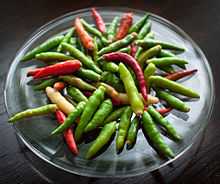Bird's eye chili
| Heat |
|
|---|---|
| Scoville scale | 100,000–225,000 |
 Several bird's eye chilis on a shrub | |
| Species | Capsicum annuum[1] |
|---|---|
| Cultivar | Bird's Eye |
Bird's eye chili, bird's chili or Thai chili is a chili pepper, a cultivar from the species Capsicum annuum, commonly found in Southeast Asia. It is often confused with a similar-looking chili derived from the species Capsicum frutescens, the cultivar 'siling labuyo'. Bird's eye chili can also be found in India, in Meghalaya and Kerala; it is used in traditional dishes of the Kerala cuisine. This cultivar is also found in rural areas of Sri Lanka, where it is used as a substitute for green chilis. It is also a main ingredient in kochchi sambal, a salad made using freshly scraped coconut ground with bird's eye chilis and seasoned with salt and lime juice. It is used extensively in Thai, Lao, Khmer, Indonesian, and Vietnamese cuisine.
Some English speakers also refer to this cultivar as Thai hot, Thai dragon, and boonie pepper.
Description

The bird's eye chili plant is a perennial with small, tapering fruits, often two or three, at a node. The fruits are very pungent.
The bird's eye chili is small, but is quite hot (piquant). It measures around 100,000–225,000 Scoville units, which is at the lower half of the range for the hotter habanero chili but still many times more spicy than a jalapeño.[2]

Characteristics of the bird's eye chili plant[3]
- Plant height: up to 2 m
- Stem colour: green
- Leaf colour: green
- Leaf size: 3–8 cm by 2–4 cm
- Fruit colour at maturity: green, orange, or red
- Fruit shape: conical
- Fruit length: 2–3 cm
- Fruit width at shoulder: 0.5 cm
- Fruit weight: 2–3 g
- Fruit surface: smooth
- Seed colour: light tan
- Seeds per fruit: 10–20
Origins
All chilis found around the world today have their origins in Mexico, Central America, and South America. They were spread by the Spanish and the Portuguese, together with many other now common crops such as maize, tomatoes and pineapples. This is now called the Columbian Exchange. The chili varieties found in Southeast Asia today were brought by Spanish and Portuguese colonists and traders in the 16th or 17th century.[4][5]
Uses by humans
As food

In Vietnamese cuisine, these chilis are used in soups, salads, and stir-fried dishes. They are also put in fish sauce as a condiment or eaten raw.
In Thai cuisine, these chilis are highly valued for their fruity taste and extreme spiciness. They are extensively used in many Thai dishes, such as in Thai curries and in Thai salads, green as well as the ripe red chilis; or they can just be eaten raw on the side, with for instance, khao kha mu (stewed pork trotter served with rice).
As ornamentals
The more decorative, but slightly less pungent chili, sometimes known as 'Thai ornamental', has peppers that point upward on the plant, and range from green to yellow, orange, and then red. It is the basis for the hybrid cultivar 'Numex twilight', essentially the same, but less pungent, and starting with purple fruit, creating a rainbow effect. These peppers can grow wild in places such as Saipan and Guam.
See also
- List of Capsicum cultivars
- African bird's eye chili
References
| Wikimedia Commons has media related to Bird's eye chili. |
- ↑ DeWitt, D.; Bosland, P.W. (2009). The Complete Chile Pepper Book: A Gardener's Guide to Choosing, Growing, Preserving, and Cooking. Timber Press. ISBN 978-0881929201.
- ↑ http://www.scottrobertsweb.com/scoville-scale/
- ↑ Growing Chili: Bird's Eye Chili
- ↑ http://content.time.com/time/specials/2007/article/0,28804,1628191_1626317_1632291,00.html
- ↑ http://books.google.nl/books?id=X9LXYwu7G50C&pg=PA79&lpg=PA79&dq=chilli+thailand+spanish+portuguese+century&source=bl&ots=YOFajdmz_T&sig=ifN3vtdnPVOGsGoeAONhgo5hXSM&hl=en&sa=X&ei=5UYpVMCAHNbiavX3gOgG&redir_esc=y#v=onepage&q=chilli%20thailand%20spanish%20portuguese%20century&f=false
- ↑ http://shesimmers.com/2010/02/nampla-prik-ubiquitous-thai-table-sauce.html
| ||||||||||||||||||||||||||